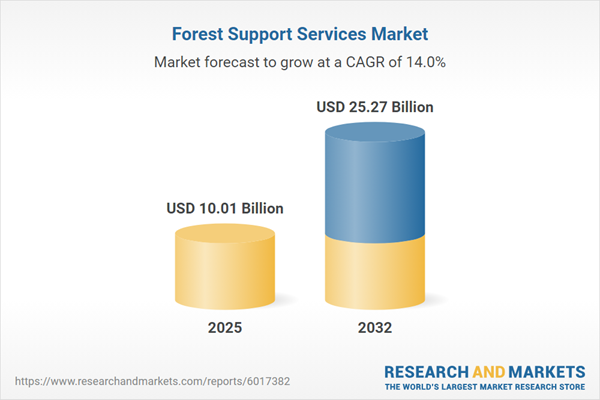Speak directly to the analyst to clarify any post sales queries you may have.
Forest support services are becoming essential in modern environmental and resource management, offering organizations strategic expertise and operational support to meet complex regulatory, sustainability, and market needs across diverse forest environments.
Market Snapshot: Forest Support Services Market Growth
The Forest Support Services Market grew from USD 8.87 billion in 2024 to USD 10.01 billion in 2025. It is projected to maintain robust growth at a CAGR of 13.97%, reaching USD 25.27 billion by 2032.
This upward trend is driven by advances in technology, intensifying climate, and policy pressures. Increased stakeholder focus on integrated solutions and market expansion across multiple regions underscore the sector’s evolving significance.Scope & Segmentation: Forest Support Services Market Analysis
- Service Types: Conservation services such as habitat restoration, water quality maintenance, and wildlife preservation; consulting services including economic, environmental, legal, operational, and technical advisory; forest management services covering health monitoring, inventory, reforestation, timber harvesting, and tree pruning; and forest protection services like fire protection, invasive species control, and pest management.
- Service Delivery Models: Advanced digital and remote services leveraging technologies such as satellite surveillance and automated analytics; traditional and manual offerings grounded in site-specific field expertise.
- Forest Types: Agroforestry systems, commercial plantations and managed timberlands, natural reserves and protected areas, and urban or community-oriented forests.
- End-Users: Commercial enterprises, government agencies, non-profit organizations, and private landowners.
- Regions Covered: Americas, including North America and Latin America; Europe, Middle East & Africa; Asia-Pacific. Major countries such as the United States, Canada, Brazil, United Kingdom, Germany, China, and India are analyzed.
- Leading Companies: AFRY AB, American Forest Management, ArborGen Holdings, F&W Forestry Services, FORECON Inc., and additional notable providers in consulting, digital analytics, and operational services.
Key Takeaways for Senior Decision-Makers
- Rapid adoption of digital platforms—such as remote monitoring and artificial intelligence—streamlines inventory management, compliance, and risk assessment for clients managing diverse forest portfolios.
- Service integration across economic, legal, operational, and technical domains is enhancing project execution, allowing for greater value delivery and proactive risk mitigation.
- Heightened demand for sustainability consulting is being met by cross-functional teams supporting compliance, restoration, and supply chain resilience objectives.
- Collaborative approaches, involving public agencies and private stakeholders, drive the success of ecosystem-based management and support regional adaptation to changing policy environments.
- Market differentiation is increasingly achieved through partnerships, digital solution bundling, and the inclusion of circular economy principles within core service offerings.
- Segment relevance is reinforced as customized solutions address specific needs across urban, commercial, rural, and protected forest environments, enabling organizations to tailor strategies and optimize impact.
Tariff Impact on Forest Support Services
The introduction of United States tariffs in 2025 has influenced procurement and supply chain choices throughout the forest support sector. Service providers are adapting by exploring alternative sourcing, increasing domestic production partnerships, and focusing on tariff navigation consulting. This environment also encourages innovation in equipment lifecycle management and amplifies the industry’s attention to circular economy practices, supporting long-term operational resilience.
Methodology & Data Sources
This market report utilizes a robust mixed-method research framework. In-depth executive and technical interviews provided firsthand insight, with validation from an expert advisory panel. Extensive secondary source review, including industry publications and government data, ensured comprehensive coverage. Data triangulation and thematic analysis offer a sound empirical base underpinning qualitative and quantitative findings.
Why This Forest Support Services Report Matters
- Confidently inform strategic investments by understanding the interplay between technology, regulations, and market dynamics in forest management.
- Leverage segmentation and regional trends to shape competitive positioning, partnership opportunities, and service innovation strategies.
- Gain actionable insights on the operational and policy levers that enable resilience and sustainable growth in a complex global sector.
Conclusion
Senior leaders will find comprehensive, actionable intelligence for advancing sustainability, efficiency, and resilience in forest support services. This analysis equips organizations to meet evolving demands and position themselves at the forefront of environmentally responsible forest management worldwide.
Additional Product Information:
- Purchase of this report includes 1 year online access with quarterly updates.
- This report can be updated on request. Please contact our Customer Experience team using the Ask a Question widget on our website.
Table of Contents
3. Executive Summary
4. Market Overview
7. Cumulative Impact of Artificial Intelligence 2025
Companies Mentioned
The companies profiled in this Forest Support Services market report include:- AFRY AB
- American Forest Management, Inc.
- ArborGen Holdings Limited
- Climate Forestry Limited
- Dalgas by Hedeselskabet
- F&W Forestry Services, Inc.
- FORECON Inc.
- Forest Resource Consultants, Inc.
- Forestry Services Ltd.
- Form International
- Forsite Consultants Ltd.
- Global Forestry Services
- Green Timber Consulting Foresters, Inc.
- Hawkins Wright Ltd.
- J.F. Brennan Company, Inc.
- Jefferson Resource Company Inc.
- Land Life Company
- LandVest, Inc.
- Manulife Investment Management
- Mason, Bruce & Girard, Inc.
- Mercer International Inc.
- Merin Forest Management
- Prime Consulting International Ltd.
- Responsible Forestry Solutions
- Samling Timber Malaysia
- Sappi Group
- SCS Global Services
- SGS S.A.
- Shultz Forest Management and Consulting LLC
- Steigerwaldt Land Services
- SWCA, Incorporated
- Terra Space Lab Ltd.
- The Davey Tree Expert Company
- Tilhill Forestry by BSW Group
- Trimble Inc.
- TUV SUD AG
Table Information
| Report Attribute | Details |
|---|---|
| No. of Pages | 186 |
| Published | November 2025 |
| Forecast Period | 2025 - 2032 |
| Estimated Market Value ( USD | $ 10.01 Billion |
| Forecasted Market Value ( USD | $ 25.27 Billion |
| Compound Annual Growth Rate | 13.9% |
| Regions Covered | Global |
| No. of Companies Mentioned | 37 |









